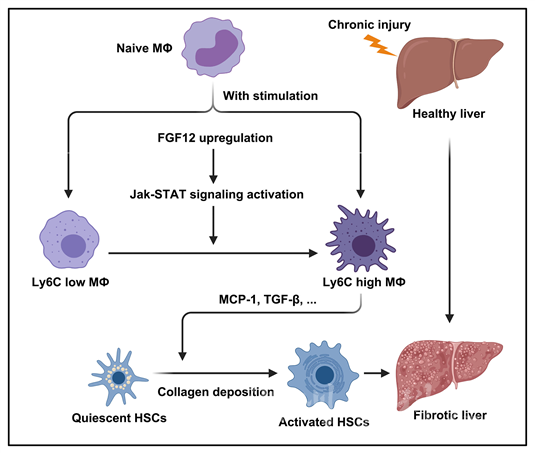- WMU Pharmaceutical Sciences Research Team Publish Research Results in Leading International Journal Hepatology, Identifying New Target for Liver Fibrosis Treatment
- Author:Li Santie, School of Pharmaceutical Sciences Date:July 11, 2022
Recently, Jin Litai's research group from Academician Li Xiaokun’s team of the School of Pharmaceutical Sciences at Wenzhou Medical University published a research paper online in Hepatology, a leading international journal in the field of hepatology. The paper detailed the role of fibroblasts growth factor 12 (FGF12) in the development of liver fibrosis and related mechanisms and clarified that FGF12 in macrophages promotes liver fibrosis progression, providing new research ideas and targets for the treatment of liver fibrosis/cirrhosis. Researcher Cong Weitao, Professor Jin Litai, and Academician Li Xiaokun are the co-corresponding authors of the paper. Li Santie, a doctoral student of the School of Pharmaceutical Sciences, Zhou Bin, director of the Hepatobiliary and Pancreatic Surgery Department of the Second Affiliated Hospital, and Xue Mei from the Central Laboratory of the First Affiliated Hospital are the co-first authors.

Liver fibrosis is a serious complication accompanied by various acute and chronic liver diseases. Without early intervention, it often leads to cirrhosis and even liver cancer, seriously threatening the life and health of patients. FGF12 is a typical intracrine cell growth factor of the fibroblast growth factor family. Unlike the common FGFs such as FGF2, FGF10, or FGF21, FGF12 does not rely on growth factor receptors for downstream-related effects. Previous studies suggested that FGF12 is mainly expressed in neurons and cardiomyocytes and plays a key role in regulating ion channels and myocardial rhythm. However, the role and mechanism of FGF12 in liver homeostasis regulation and liver fibrosis progression remain unclear.
The study of the research group showed that FGF12 was significantly up-regulated in different liver fibrosis mouse models. FGF12 was mainly expressed in nonparenchymal liver cells compared with liver cells. Further studies confirmed that hepatic macrophages might be the main source of FGF12 expression during fibrosis. The research group found that the liver fibrosis induced by bile duct ligation and carbon tetrachloride injection was significantly alleviated in macrophage-specific FGF12 knockout mice, indicating that FGF12 in macrophages promoted liver fibrosis progression. The study also pointed out that FGF12 increased the population of lymphocyte antigen 6 complex locus C high macrophages in fibrotic liver tissue, and induced HSC activation through the monocyte chemoattractant protein-1/chemokine (C-C motif) receptor 2 axis, thus aggravating liver fibrosis. In order to further confirm the association between FGF12 and liver fibrosis, the research group conducted experimental analysis in human liver tissue samples and found that the expression of FGF12 was positively correlated with the severity of liver fibrosis, which further demonstrated the function and role of FGF12 in regulating the occurrence and development of liver fibrosis. The study shows that FGF12 is an important factor in regulating liver homeostasis, and indicates the feasibility of FGF12 as a therapeutic target for liver fibrosis treatment.

Article link: https://pubmed.ncbi.nlm.nih.gov/35753047/
Text translated by MiaoYu and reviewed by SunYou
